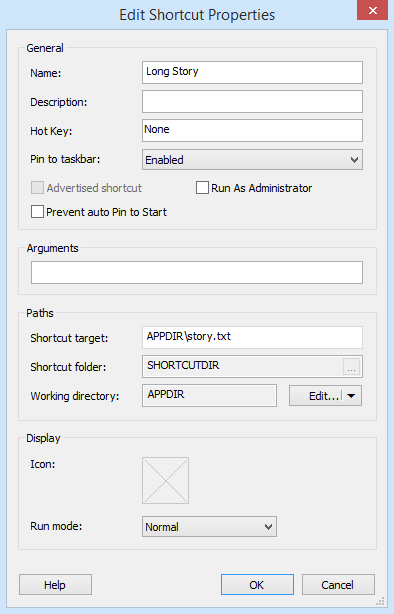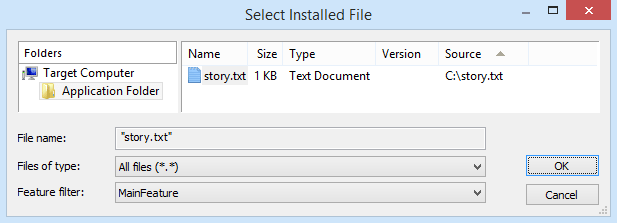1. Create project
Let's suppose that you want to create a package to install a simple text file, a story you wrote. Choose an already existing text file on your local disk or create one. Name the file story.txt, open it in your favorite text editor, and type a couple of lines to give it some content.
After launching Advanced Installer, you will be presented with a dialog where you can choose the type of project you want to create.

- Select the “Simple” type.
- Uncheck the “Use wizard...” option.
- Press the
- The new project has been created and from now on you can edit it.
![]() Save the project by using the
Save the project by using the
A common mistake made by developers new to Advanced Installer is creating a project then copying it and using the copy as a base for a new project. This is wrong, it leads to duplicate ProductCode and UpgradeCode. The article on Product Identification explains why this is wrong in the "Copying your project files" section.
2. Add files
The most important step in creating an MSI package is adding a file or folder.
![]() Switch to the “Files and Folders” page by selecting it in the left-side panel. The folders which interest you most are “Application Folder” and “Application Shortcut Folder”.
Switch to the “Files and Folders” page by selecting it in the left-side panel. The folders which interest you most are “Application Folder” and “Application Shortcut Folder”.
In Application Folder, you can add the files and folders used by your application, this folder representing the installation folder. In Application Shortcut Folder you can add shortcuts to your application, to a help file or to a URL, this folder representing a folder in the “Start > All Programs” menu of the Windows taskbar. You can read more about these folders in the Install Parameters page.
![]() Click on the
Click on the

3. Build and install
Now that you have added a file to your project let's build the MSI package.
![]() Click on the
Click on the
![]() Once the build is complete, click on the
Once the build is complete, click on the
Congratulations! You have created your first Advanced Installer MSI package. By default, the story.txt file will be installed in C:\Program Files (x86)\Your Company\Your Application. Browse to that folder in Windows Explorer to check.
4. Remove installed file
You can remove the installed file either from the “Programs and Features” in the Control Panel or from within the Advanced Installer application itself. Simply press the
If you change anything in the project, pressing
5. Edit product and company names
Of course, “Your Company” and “Your Application” aren't too expressive names for the story you are trying to distribute. Let's change them.
![]() Switch to the “Product Details” page by selecting it in the left-side panel and edit them to better values.
Switch to the “Product Details” page by selecting it in the left-side panel and edit them to better values.

Build and Run the package again to check the results. Don't forget to uninstall afterward.
6. Create shortcuts
Installing in Programs Files(x86) is not of much use if we don't create shortcuts to the installed file. We will create two: one in the “Start” menu and another one on the desktop.
![]() Start by switching back to the “Files and Folders” page.
Start by switching back to the “Files and Folders” page.
![]() Select the story.txt file by clicking on it, then click on the
Select the story.txt file by clicking on it, then click on the

Change the shortcut name to “Long Story” and click
To also create a shortcut that will be installed on the Target Computer's desktop, select the Desktopfolder in the “Folders” tree and click the

Select story.txt and press
Build and Run again to check the results, uninstall when you're done.
7. Change product version
In time, you may want to release a new version of the story. Maybe you want to fix some issues discovered in the first release. Nothing easier with Advanced Installer.
First, open the story.txt file your favorite text editor and add a couple of lines to it, so that we have an actual file change.
![]() Then switch to the “Product Details” page by selecting it in the left-side panel. Edit the “Product Version” field to “2.0.0”.
Then switch to the “Product Details” page by selecting it in the left-side panel. Edit the “Product Version” field to “2.0.0”.
When building, saving or selecting another page, you will be asked to generate a new Product Code. Answer “Generate new” if you want the new package to automatically upgrade the previous version of the story, if found on the target computer. If you answer “Keep existing”, the two versions will be prevented from being installed simultaneously on the same computer.